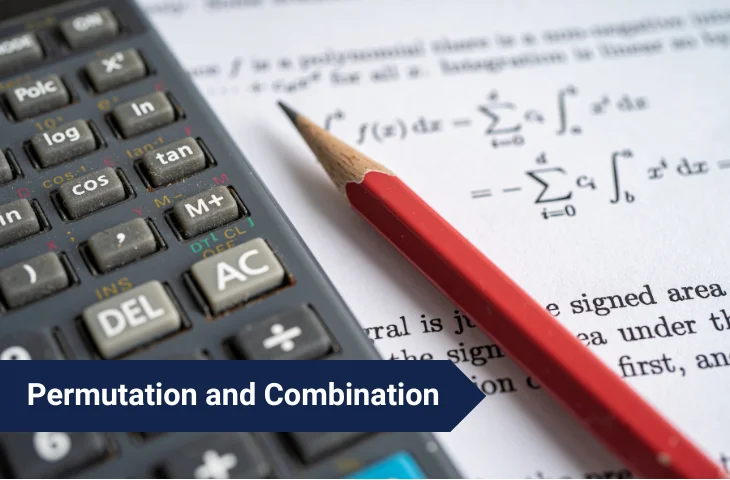Permutation and Combination is a crucial topic in the Quantitative Aptitude section of various competitive exams. It deals with counting, arrangement, and selection problems and requires a logical and analytical mindset. In this blog, we have provided permutation and combination short notes, formulas, exam-wise tricks, solved questions from 2024–25 exams, and more.
What Is Permutation and Combination in Quantitative Aptitude?
Permutation and Combination (PnC) is a branch of mathematics that deals with arrangement (permutation) and selection (combination) of objects.
- Permutation is concerned with arranging items in a specific order.
- Combination is about selecting items without caring about the order.
Why is it asked in exams?
Examiners test PnC to assess a candidate’s ability to logically count possibilities under different constraints. It’s often used in questions related to digits, alphabets, passwords, seating arrangements, and more.
Skills Required:
- Logical reasoning
- Basic number theory
- Visualisation & scenario analysis
- Understanding of constraints in a problem
Why Is Permutation and Combination Important in Competitive Exams?
Permutation and Combination is considered as a tough topic for many aptitude-based competitive exams. Questions are often direct and formula-based, making it scoring with the right practice.
| Exam | No. of Questions | Difficulty |
| SSC CGL / CHSL | 1–2 | Easy |
| IBPS PO / SBI PO | 1–2 | Moderate |
| RRB NTPC / Group D | 1 | Easy |
| State PSC / Police | 1–2 | Moderate |
Permutation and Combination Quantitative Aptitude Short Notes
Some of the common terms used for permutation and combination questions are as follows:
| Term | Definition |
| Factorial (n!) | Product of all positive integers up to n. For example, 5! = 5×4×3×2×1 = 120 |
| Permutation (nPr) | Number of ways to arrange r items from n distinct items: nPr = n! / (n–r)! |
| Combination (nCr) | Number of ways to select r items from n distinct items: nCr = n! / (r!(n–r)!) |
| Repetition Allowed | Permutations or combinations where repetition is allowed |
| Circular Permutation | Arrangement in a circle. (n – 1)! ways if clockwise/anti-clockwise are same |
Concepts Based on Permutation and Combination
Some of the concepts used in permutation and combination questions are as follows:
| Concept | Details |
| nPr = n! / (n – r)! | Use when order matters in the arrangement |
| nCr = n! / (r!(n – r)!) | Use when order does not matter in selection |
| Circular Permutation | (n – 1)! if there’s no fixed starting point |
| Permutation with Repetition | n^r when each of r positions can have any of n items |
| Identical Items | Total permutations = n! / (p! × q! × …) where p, q are identical item counts |
| nCr = nC(n – r) | Symmetry property of combinations |
What Are the Types of Permutation and Combination Questions in Quantitative Aptitude?
In SSC, Banking, and RRB exams, Permutation questions can appear in various forms:
- Direct Formula-Based Questions – Simple application of nPr or nCr
- Repetition/Restriction-Based Questions – Includes digits/letters with specific constraints
- Circular Arrangement – People seated in a circle; often appears in SSC exams
- Digit/Word Formation Puzzles – Using alphabets or numbers to form new codes
- Mixed Concept – Includes logical conditions + counting + arrangement
Permutation and Combination Formulas for Quantitative Aptitude
Some of the used formulas for the permutation and combination are as follows:
- nPr = n! / (n – r)!
- nCr = n! / [r!(n – r)!]
- nCr = nC(n – r)
- nPn = n!
- Number of circular permutations = (n – 1)!
- Permutations with repetition = n^r
- Permutations with identical items = n! / (p! × q! × …)
Permutation and Combination Tricks for SSC CGL and Other Exams
Tricks used for permutation and combination are as follows:
- Order matters? → Use Permutation
- Selection only? → Use Combination
- Use symmetry: nCr = nC(n–r) to simplify calculations
- Look for restrictions early: e.g., vowel must come first
- Eliminate impossible cases before calculating possibilities
- In circular arrangements, fix one position to avoid repetitions
- Use digit rules: For forming even/odd numbers, focus on last digit first
Solved Permutation and Combination Questions from 2024–25 Exams
Question 1
Asked in SSC CGL 2024 Tier 1 Shift 2 – Memory-Based
How many 3-digit numbers can be formed using digits 1, 2, 3, 4, 5 without repetition?
Answer: 60
Explanation: 5P3 = 5 × 4 × 3 = 60
Question 2
From IBPS PO Prelims 2024 – Oliveboard Mock
How many ways can the word “EXAM” be arranged such that vowels are always together?
Answer: 12
Explanation: Group vowels (E, A) together ⇒ (EA/M/X), so 3! arrangements × 2! (EA or AE) = 6 × 2 = 12
Question 3
Based on memory from SBI PO Mains 2025
From 6 men and 4 women, a committee of 5 is to be formed. How many ways if at least 3 women must be there?
Answer: 80
Explanation:
- 3W + 2M → 4C3 × 6C2 = 4 × 15 = 60
- 4W + 1M → 4C4 × 6C1 = 1 × 6 = 6
- 5W → Not possible (only 4 women)
Total = 60 + 6 = 66
Permutation and Combination Concepts for Bank Exams
In banking exams like IBPS and SBI, questions often involve coded variations or restrictions like:
Example:
“How many 4-letter codes can be formed using A, B, C, D, E such that the code begins with a vowel and no letter repeats?”
Solution:
Vowel choices (A, E) = 2
Next 3 letters: 4P3 = 24
Total = 2 × 24 = 48
These problems test logical structuring along with counting.
Common Mistakes to Avoid while Solving Permutation and Combination
Common mistakes to avoid while solving these types of questions are as follows:
- Confusing permutation with combination – Always ask: “Does order matter?”
- Ignoring constraints – e.g., “must start with vowel” changes total cases
- Overusing repetition – Check if repetition is allowed or not
- Incorrect factorial simplification – Practice factorial shortcuts
- Misunderstanding circular permutations – Fix one position to avoid overcounting
FAQs
Permutation is for arrangement (order matters), combination is for selection (order doesn’t matter).
Use nPr when order matters, use nCr when it doesn’t.
(n – 1)! when clockwise/anticlockwise arrangements are considered the same.
Yes, repeated items in r places from n elements = n^r.
Count letters, check for repetition, and apply n! / repetition factorials.
- BOI Apprentice Salary 2025, Check Stipend Details
- Upcoming Bank Exams 2026: SBI, IBPS, IBPS RRBs, Insurance Exams
- Bank of India Credit Officer Syllabus 2025, Check Exam Pattern
- Punjab and Sind Bank LBO Interview Result 2025 Out, Download PDF
- SSC CGL Tier 2 Previous Year Paper, Download Free PDF
- SSC CGL 2025 Tier 1 Question Papers, Shift-Wise PYPs, Download PDFs

Hi, I’m Aditi. I work as a Content Writer at Oliveboard, where I have been simplifying exam-related content for the past 4 years. I create clear and easy-to-understand guides for JAIIB, CAIIB, and UGC exams. My work includes breaking down notifications, admit cards, and exam updates, as well as preparing study plans and subject-wise strategies.
My goal is to support working professionals in managing their exam preparation alongside a full-time job and to help them achieve career growth.
